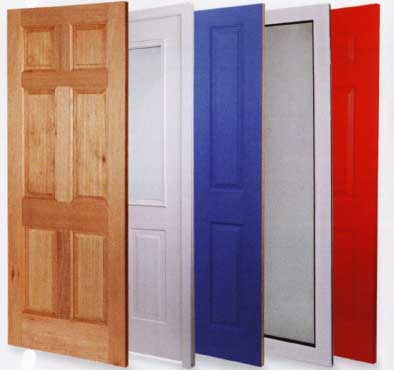Both exterior and interior door systems should keep with the architectural style of your home. Exterior doors are often thicker and more durable to withstand the elements. When buying a new door, remember that all door hardware, such as handles, locks, latches, letter slots, knockers, and so on, are normally bought separately and then installed.
Types of Doors
The simplest way to categorize the wide range of doors is to consider if they are for exterior use, such as a front door or a garage door, or for interior use within the home.
Entry Doors
A wide range of entry doors is available, the most common of which are shown here. The material of the door is an important indicator of its durability, and will also determine if a finish is required. The age of the building will affect your choice -- a paneled design is more appropriate for, an older building, for example. The manufacturer should supply details of recommended locks. Many exterior doors are supplied as part of a doorset (i.e., with, or already installed in, a frame). If you are replacing a door that also needs a new frame, see opposite.Common Entry Door Types
Type |
Information |
Finish |
Wood |
Hardwood is most durable. Softwood is cheaper, but higher-maintenance. |
Use a varnish or paint suitable for exterior work |
Vinyl |
Thermally efficient, and low-maintenance. Always supplied as part of a doorset. |
Factory-finished. No need to paint after installation |
Fiberglass |
Made of a wooden framework with large areas of insulation. Often pressed or molded for a wood-grain effect. |
May be supplied pre-finished. If not, finish with varnish or paint |
Sliding patio |
Supplied in sections, with a frame. Some have both doors on runners; others have only one door sliding and opening. |
Door shown left is vinyl in a vinyl frame |
Steel |
May comprise a wooden core, covered with steel; or may have a steel internal frame with wooden covering. |
May be factory finished. Handles and locks may be factory-fitted. |


Interior Doors
As with entry doors, there is a wide range of interior doors on the market -- the most common are shown here. Interior doors are lighter, and tend to cost less than exterior doors. Flush doors are generally cheaper than paneled ones. Again, choose a design appropriate to the age of your home. The manufacturer should supply details such as whether the door is fireproof or has soundproofing capabilities.
Door Security
Choosing a door based upon curb appeal is usually the top consideration on most homeowners’ list. But don’t overlook security when selecting entry doors. If you must decide first the style and color of door that best fits with your home’s design, weigh the security and strength issues for the doors in that category. Doors with steel cores and solid wood doors are the best options for resisting break-ins. Door locks are the most obvious step to securing doors, but if the door isn't installed correctly, the lock won’t matter. Check the entry doors periodically to make sure they close tightly and they hang plumb in their frames.
Entry doors that feature glass panes will let in light and allow you to see who is at your door, but glass in parts of the door or as sidelights can make your home more vulnerable to break-ins. By breaking the glass, a burglar can simply reach inside your home to undo the locks. If you are concerned about burglars, you may want to choose a door that has glass panels on the top or small panes that don’t allow easy access to the locks.
Common Interior Door Types
Type |
Information |
Finish |
Panel |
Two types: solid and pressed. Solid is of hardwood or softwood; sometimes made of knot-free wood. Pressed version mimics the grain and panels of solid, with molded hardboard, making it cheaper and lighter, |
Solid may be painted, or finished using a natural wood system. Pressed is only suitable for painting |
Glazed |
Glass is often supplied. Ideal door for a room requiring light. |
Tape glass before priming and painting |
Louver |
Angled slats for ventilation/decoration. Ideal door type for closets. Hung with hinges, or used as a bifold or as a sliding door. |
May be painted, or finished using a natural wood paint or finish |
Bifold |
Fixed to the door jamb with butt hinges. Butt hinges also connect the sections. May have a sliding rail mechanism at the top. |
May be painted, or finished using a natural wood paint or finish |
Ledge-and-brace |
Made up of tongue-and-groove sections, braced with horizontal and diagonal lumber. Softwood or hardwood. Ideal for rustic-style home. |
May be painted, or finished using a natural wood paint or finish |
Framed ledge-and-brace |
Ledge-and-brace construction, in a frame for extra strength. Sometimes used as an exterior door. Stable doors are based on this design, cut horizontally in two. |
May be painted, or finished using a natural wood paint or finish |
Flush |
Cheaper than panel doors. Two types: solid and hollow. Better-quality versions have solid timber core, with a softwood frame for hinging and latch fitting, Hollow flush doors are cheaper. |
Solid may be pre-finished with a wooden veneer. Hollow versions are mostly designed for a paint finish |
